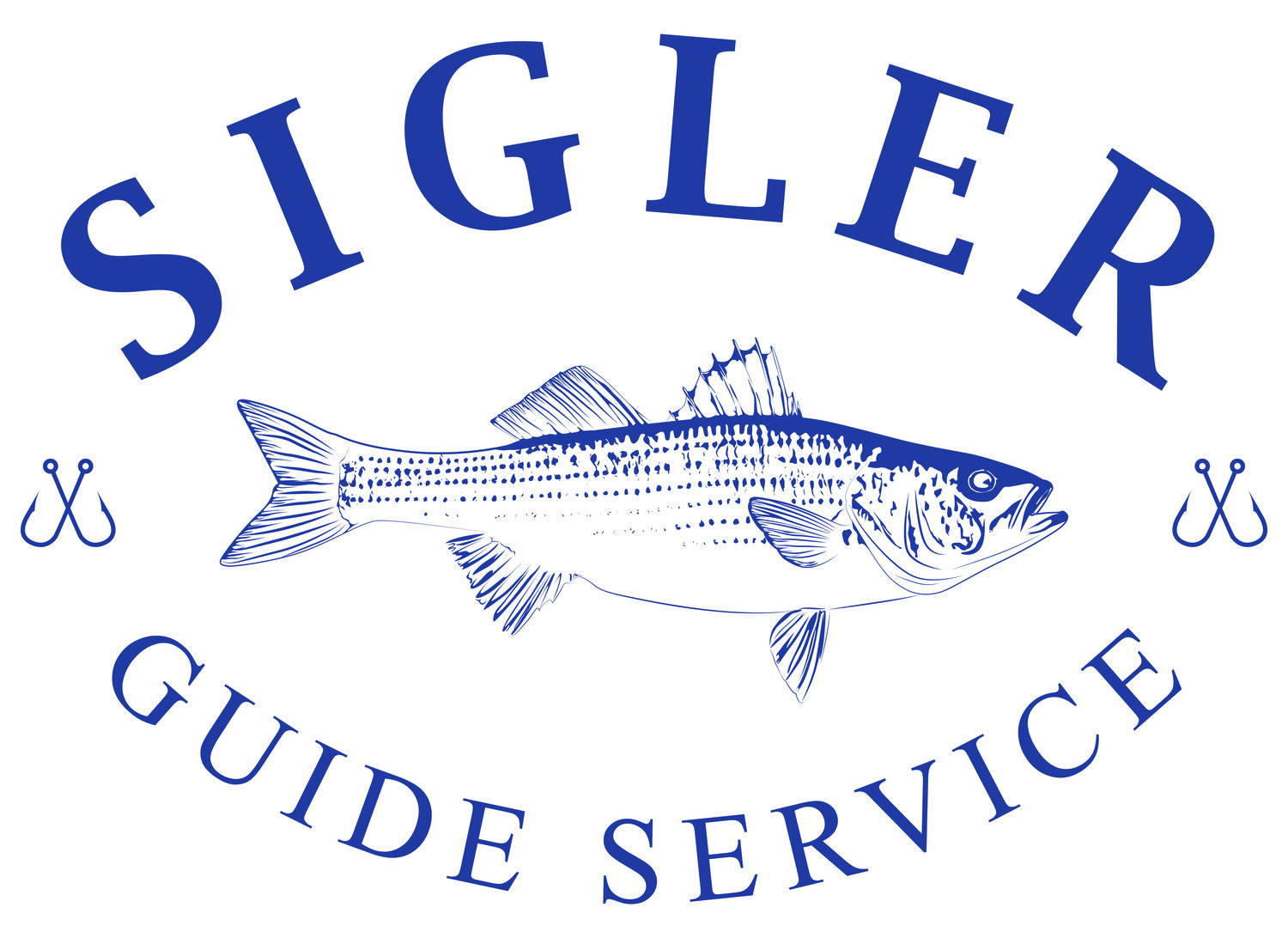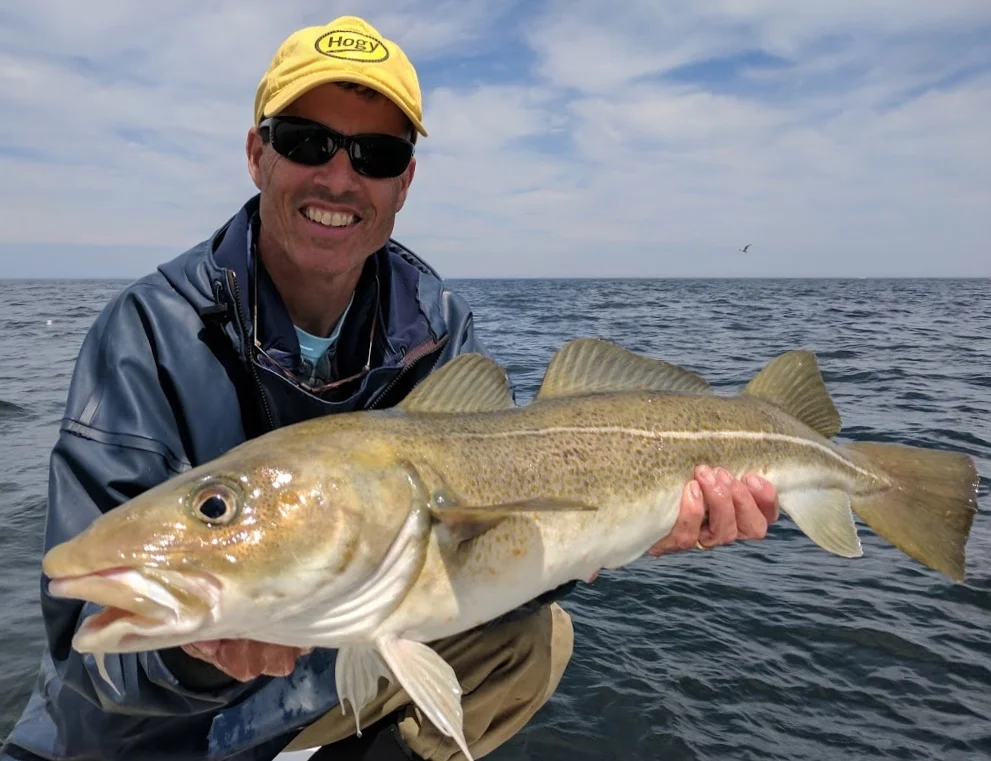The Fish We Catch
The following is a brief description of the species that we fish for, as well as some of the techniques that we use. It is by no means a complete list of what we might run into, but in general, this is what we can chase. We also maintain a recreational lobster license, so if you are interested in seeing how lobsters are fished, make a point to ask. It is a particular highlight for the kids.
Striped Bass
The Striped Bass fishery that we have lends itself to a wide array of tackle and approaches, including fly fishing, casting artificials, and fishing live bait. When fly-fishing, we are typically “pocket fishing” ... Casting streamers right into the frothy white water along the shoreline. It is a very active style of fishing, requiring focus and attention to placement and retrieve. A good cast and retrieve stands a very good chance getting hit. Most of the fish in these pockets are in the 18” – 25” range, though we have taken fish over 40” this way. This type of fishing is far more fun than blind casting flats, channels or holes.
For the non-fly fisher, there is still plenty of fun to be had! Casting swimming plugs and rubber baits on light spinning gear is generally very effective. This fishing is quite similar to the fly-fishing in that we are casting right into the same frothy pockets, targeting the same 18” – 25” fish. Casting proficiency comes in quite handy when targeting this pocket water.
If you're looking for a dinner fish, or just want some crazy action, then live bait fishing is the way to go. This is also a great method for folks who are not experienced casters. Depending on bait availability, this method generally provides the most action and the largest fish … all on the same light spinning gear.
Other situations which sometimes present themselves include open water surface feeds, bass/bluefish tailing and fining on the surface out in open water, or some very exciting sight casting to large bass cruising over shallow grass flats, and night fishing the numerous lighted docks and piers around the harbor!
Bluefish
Bluefish are great fun on the fly rod or light spinning tackle. Although they can be caught throughout the season, the fall migration is when they can truly be targeted. By late August, as the waves of bait start moving through the area, the blues can be found rampaging hapless pods. The action usually starts to taper off as September winds down. Most of the fish are in the 5 – 12 lb. range, and put up quite an account for themselves. Birds are often a giveaway to the location of the blitzes, and there is nothing like an acre of frothy, bubbling carnage to get your adrenaline pumping.
Cod
Although there can be some inshore action for smaller cod, to really target them requires an offshore trip. Fishing jigs and/or bait in 150’ – 250’ of water on some of the offshore humps and banks is the ticket. We often fish for cod during Tuna/Shark trips while we are waiting for a bite. Unlike most of the offshore fleet, we prefer to stick with the lighter tackle (spinning and conventional) when cod fishing.
Cod are one of the finest eating fish in the sea, but unfortunately Cod stocks are currently at a low point, so seasons and regulations are often changing. It is best to check in with us if you are interested in a dedicated cod trip.
Haddock
Very similar to Cod, but with much healthier populations, haddock are a fantastic eating fish. We target them the same way as described above for codfish, though bait often outperforms jigs. As with Cod, Haddock are often a targeted while we are waiting for a bite during shark/tuna trips.
Pollock
Pollock is our new favorite food fish! Not quite as white as cod/haddock, but absolutely delicious. … AND, Pollock stocks are very robust, so this is a very sustainable fishery. Pollock range from small bait sized fish, up to large 15 – 20 lb fish. They are targeted the same way as for cod and haddock, but tend to swim in larger schools … so if we find one, we often find many.
Bluefin Tuna
We tend to have two distinct types of tuna fishing that we do. One is for smaller “recreational” fish, the other is for larger “commercial” fish. The recreational fishery has developed quite a bit in the last ten years. It is one of our least consistent fisheries, but when it is on, it can be mind blowing! The fishing is centered around cruising a large area of open water, looking for fish busting bait on the surface. If we can find a concentration of fish working bait, we try to cast a fly or light spinning lure into the melee. If the line comes tight, we’re in for the angling experience of a lifetime. Again, hard to predict, and low odds of success, but an unbelievable thrill if it happens.
Targeting larger fish is generally a live bait fishery. We anchor up or drift over offshore banks or humps that have been holding fish, and set out several live and/or baits (mackerel, herring, pogies, whiting, etc). Baits may be fished deep under the boat, shallower under balloons, or on the surface under kites. This is very much a waiting game, and it is not uncommon that we do not hook up. However, when it does happen, it is an experience unlike anything else. Even without hooking up, these offshore trips typically offer a wealth of other entertaining aspects, from seeing whales, porpoises, sharks, and/or ocean sunfish, to bottom fishing for cod/haddock/pollock, etc.
Trips in our center consoles are less expensive, and typically limited to three people. Trips on our larger boat are more expensive, but can handle five in serious comfort :)
Sharks
Shark fishing has become quite a hit for us … particularly with kids! The primary species we run into is the Blue Shark. These fish run from 6’ and under 100 lbs to over 12’ and 450 lbs. The basic process is to find an offshore hump (40 – 60 min run), set up a chum line using frozen blocks of ground herring, and then drift with baits out. While we are drifting, we are typically bottom fishing for Cod/Haddock/Pollock, etc. Other species of sharks that we occasionally run into include Porbeagle and Thresher. The shark fishery is a “Catch-and-Release” fishery, so there are no “Hero pictures” of everyone standing around a dead shark, and no thrashing jaws in the cockpit … they all swim happily back to the depths.






